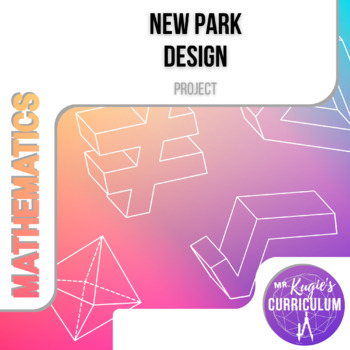New Park Design | Math Project
- PDF
- Internet Activities
- Easel Activity
Description
PURPOSE:
This 3-week project will allow your students to design their very own city park according to specifications provided by the city and a moderate budget. But this is no regular end-of-year project; every aspect of this project is directly related to real-world cost, use, and application.
Students will use the equipment sold on www.gametime.com to make choices about what they wish they had in a park in their neighborhood. But building a park is more complicated than just picking a park and planting trees. Students will have to calculate areas for a dog park, basketball courts, and even the concrete running path that they will include in their park. Students will have to consider which surfacing option for their playground will be the most efficient or cheapest. Prices of these can vary by the ton or the cubic feet that they occupy. Students will be converting units, calculating volumes and areas, deciding on cost effectiveness, and balancing a budget to create the most exciting park they can that still follows the city's requirements.
WHAT’S INCLUDED:
This product contains:
✏️ Step-by-Step Instructions
✏️ Items & Specifications Page
✏️ Budgeting Spreadsheet
✏️ Building an Ideal Park Brainstorming Sheet
✏️ Map / Blueprint Printable
✏️ Extension Activities
✏️ Rubric
✏️ Project Examples
✏️ An assignable Easel activity
STORY:
After teaching many weeks of decimal multiplication and division and getting some practice balancing budgets, I wanted a way to let my students practice these skills using a bit of their own creativity and choice. But perusing the other projects on Teachers Pay Teachers, I noticed that most of them felt like "fluff" and didn't really get to the real-world mathematics or problem-based learning for which I was truly looking.
POSSIBLE EXTENSIONS:
When they finish their project designs they have their choice of 4 extension activities outlined in the file including designing a radio advertisement to raise money for the park, writing a letter to the mayor, creating a project proposal for a board meeting, or designing a brochure to bring new people to the park.
MATERIALS/PRE-REQS:
Besides this file, you may require:
✏️ Computers/iPads for the students to use gametime.com
✏️ Rulers for accurate map drawing
✏️ Calculators (optional)
*********************************************************************
RELATED INNOVATIONS from Mr. Kugie’s Curriculum
Categories:
Products:
☆ Branches of Science | Sci Project
☆ Math Sweet Truth | Math Project
☆ Become a Physicist | Sci Project
*********************************************************************






